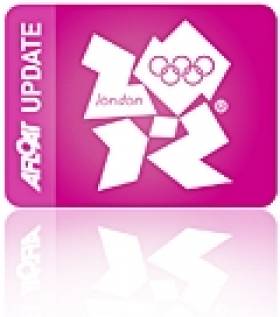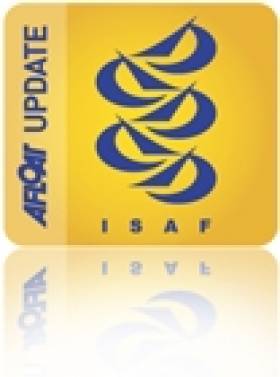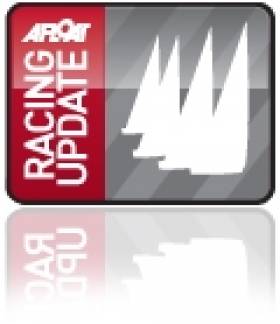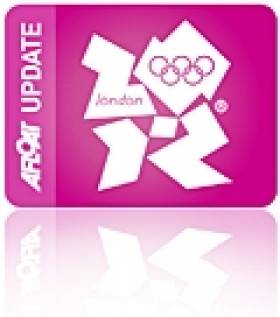Displaying items by tag: 49er
Irish Olympic Sailing Trials Commence in Holland
Irish sailing's bid for Olympic glory in London next year kicks off today when rival helmsmen Max Treacy and Peter O'Leary square up for the right to represent Ireland next July at the Olympic Regatta in Weymouth.
The Irish Star keelboat Olympic trials gets underway today on the waters off Medemblik, Holland as part of the massive ISAF Delta Lloyd regatta.
O'Leary with new crew (and triple Olympian) David Burrows will go head to head with Treacy and Anthony Shanks in a 23-boat fleet that has attracted all the top teams, a mirror of next year's Olympic regatta itself.
Also competing in Holland is Laser Radial sailor Annalise Murphy and the two 49er crews.
The new procedures set out for Olympic qualification were announced by the Irish Sailing Association in January.
The fifth of seven ISAF Sailing World Cup Regattas runs in Medemblik until 29 May.
The 2010-2011 ISAF Sailing World Cup has seen some of the world's best fleet racing sailors, match racing sailors and paralympic sailors compete as they prepare for the 2012 Olympic Sailing Competition which will be held in Weymouth, England.
And the Star class is no exception featuring another field full of Olympic medallists and world champions. World #1 and current ISAF Sailing World Cup Star Standings leaders Robert Scheidt and Bruno Prada (BRA) will be looking to hit the sort of form that has seen them pick up the gold medal at US SAILING's Rolex Miami OCR and the Semaine Olympique Française.
The pair, who won silver at the 2008 Olympic Sailing Competition, will face stiff competition in Medemblik from compatriots and 2004 Olympic gold medallists Torben Grael and Marcelo Ferreira. Grael and Ferreira are currently #10 in the world and find themselves ninth in the Star Standings. Also set to attend is 2008 Olympic gold medallists and Trofeo S.A.R. Princess Sofia MAPFRE winners Iain Percy and Andrew Simpson (GBR) and last years Delta Lloyd Regatta winners and 2009-2010 ISAF Sailing World Cup Star Champions Eivind Melleby and Petter Morland Pedersen.
Ed Wright (GBR) has finished at the top of the ISAF Sailing World Cup Finn Standings for two years in a row. But this year he looks like relinquishing his crown with Ben Ainslie (GBR) currently leading the 2010-2011 Standings on 60 points after three regatta victories compared to Wright's 46 points with a best place finish of second at Sail Melbourne.
Wright will have a chance to close the gap on Ainslie in Medemblik as the multiple Olympic gold medallist will not be attending. Nonetheless Wright will have his work cut out with World #1 Ivan Kljakovic Gaspic (CRO), World #10 Dan Slater (NZL) and the Netherland's own Pieter-Jan Postma all registered to sail in the 74 boat fleet in Medemblik.
In the Men's RS:X Dorian Van Rijsselberge (NED) has sailed at the Rolex Miami OCR and at the Trofeo S.A.R. Princess Sofia MAPFRE and convincingly won both regattas. But after missing out the Semaine Olympique Française he lost his spot at the top of the Men's RS:X Standings to Shahar Zubari (ISR) who has a three point lead having finished in the top ten in Miami, Palma and Hyères.
But of the top ten in the Men's RS:X Standings only Van Rijsselberge, Ricardo Santos (BRA) in seventh and Aichen Wang (CHN) in tenth will sail so all will have a chance to climb up the overall Standings.
In the Women's RS:X there are 42 sailors registered to compete with Australia's three time Olympian Jessica Crisp the highest placed sailor in the Standings set to attend. Crisp is eleventh just two points ahead of Patricia Freitas in twelfth and Flavia Tartaglini (ITA), the bronze medallist in Medemblik in 2009 at 13. All three will be set to take their opportunity to claim a medal and move up the Standings.
The top five teams on the 49er Standings are not set to compete in Medemblik but this is still a high class field. The fleet includes World #5 Steve Morrison and Ben Rhodes (GBR), World #10 Emil Toft Nielsen and Simon Toft Nielsen (DEN) and World #9 Nathan Outteridge, direct from the Zhik SB3 Worlds, and Iain Jensen (AUS).
Sailing Determined to 'Stand on Podium' in 2012
Irish sailing bosses are determined to "stand on the podium" at the 2012 Olympic Games.
That was the message from last week's briefing by Ireland's four Olympic 'water sports' of canoeing, rowing, swimming and sailing, covered in The Irish Times.
For next summer the Irish Sailing Association has narrowed its focus on three boat classes - the Star Class, 49er and Laser Radial.
But the competition will be tough, with more than 40 countries vying for a handful of remaining Olympic spots at the Perth Sailing World Championships in December.
Other sports are more modest in their aspirations, with rowing rebuilding from the ground up with younger athletes, and Swim Ireland pushing forward with a streamlined team and plans to have six swimmers compete in London next summer.
In canoeing, Eoin Rheinisch - who placed fourth in the canoe slalom in Beijing - was on hand to discuss his qualification hopes, with two chances to clinch a spot between now and the games.
The Irish Times has more on the story HERE.
Irish 49ers Compete in Hyeres Olympic Sailing Week
The French teams of Pierre Leboucher and Vincent Garos added two victories to climb to the top of the scoreboard in the 470 men. They are closely followed by Nicolas Charbonnier and Jérémie Mion (FRA) in second while Mat Belcher and Malcolm Page (AUS) are getting into third place.
"We are confident with our racing, but we need to keep realistic as we are only half way through the regatta. This is our first selection regatta so, to be in competition is a real motivation."
In the Laser radial, it is Princesa Sofia champion Sara Winther (NZL) who claims the day and the lead with top 3 racing. The French are also present in the top three with Sarah Steyaert (FRA) in second and Sophie de Turckheim in third.
British sailors are leading in the 49er and the Finn.
Dylan Fletcher and Alain Sign (GBR) have enjoyed the difficult conditions with two bullets and a second in the 49er fleet. They are six points ahead of Emil and Simon Nielsen (DEN) and Dave Evans and Ed Powys (GBR).
"It was a really good day at the office. It all just seemed to come together, we got good starts, had good boat speed. It was a great day. We tend to like a bit of breeze – we can just throw the boat around and actually have a laugh jumping downwind but today was a bit more tense and you have to try and concentrate on boat speed all the time."explain the leaders.
Giles Scott, winner of the Rolex Miami OCR has taken a one point lead in the Finn fleet in front of Ben Ainslie now on equal points with Pieter-Jan Postma. Dan Slater (NZL) has won both races in his group in fourth position.
In the RS:X men, World Champion Piotr Myszka (POL) who shared the day's bullets with Shahar Zubari is in front of the men's windsurfers. He is only one point from the Beijing Bronze medallist who is playing his Olympic selection in Hyères.
In the other classes early leaders are comforting their top position.
World champion Blanca Manchon is showing her skills in the mixed conditions encountered since the start of the week. She wins today's both races in the medium breeze. Charline Picon remains in second place in front 2009 SOF winner, Cheina Pen (CHN).
Blanca Manchon explains her day: "I have been very fast and had a good day. I am racing at my best level. I don't want to push too much because the next event for me, Sail for Gold, is very important as it is part of our Olympic selection. I have well chosen the equipment for this event and everything is working fine. I will try and keep racing at this level tomorrow because it is the last day for qualifications and from Thursday all the best will race together. Feelings on the water can't be better and the wind so far has been with us."
Tom Slingsby (AUS) remains in first place in the Laser, with Javier Hernandez (ESP) climbing to second. Andy Maloney takes third. Class favourites, Andreas Geritzer (AUT), Michael Bullot (NZL), Julio Alsogaray (ARG), or British Paul Goodison and Nick Thompson (GBR) have suffered from the day's conditions and are outside the top 20.
Tara Pacheco and Berta Betanzos (ESP) are continuing on their good form with consistent top four
results. They have gained a eight points lead over Penny Clark and Katrina Hughes (GBR).
The Star class had one of the longest day on the water with three long races. Three places in the top four have given early leaders Robert Scheidt and Bruno Prada (BRA) a ten points lead over George Szabo and Mark Strube (USA). Diego Negri and Enrico Voltolini (ITA) are third.
In the women Match-racing, the top six teams have qualified for the Gold group. Claire Leroy is the only team to go in the Gold undefeated wit seven victories.
"It was a very nice day. We were strong with tight matches especially against the Finnish who was very fast. We fought hard, and gave penalties to all our opponents. To be in the Gold group means less stress and more time to get prepared for the quarter-finals." explains Leroy.
She is joined by Skudina (RUS), MacGregor (GBR), Barkow (USA), Groeneveld (NED) and Echegoyen (ESP) who qualifies for the first time in the Gold group. However, Palma Silver medallist Lehtinen (FIN) has narrowly missed the repechage and will continue in the Silver group.
In the three Paralympic classes, yesterday leaders have conserved their position.
Tomorrow will be the last chance for sailors racing in groups to qualify for the final stage and the Gold group
Who is the Fastest of 'em All: Kite v Moth v 49er?
For most involved in conventional stick and cloth boating, the 49er dinghy is the ultimate speed machine. Its description as 'the high performance class' at the Olympic regatta gives it that ultimate status. Before you watch the vid below tho, ask yourself what's fastest: Moth, kiteboard or 49er.....choose carefully before clicking play on this (strong language) video!
No Recommendation for Mens Keelboat Poses Problem for Star
There was big news yesterday from the ISAF events committee meeting in Athens. The conference blog reports A 'packed session' heard the Events Committee's recommendation on the provisional Olympic events and equipment for 2016.
The Events Committee recommends:
- Board or kite-board for men and women - equipment evaluation
- One person dinghy men - Laser Standard
- One person dinghy women - Laser Radial
- Two person dinghy (skiff) men - 49er
- Two person dinghy (skiff) women - equipment evaluation
- Second one person dinghy men - Finn
- Two person mixed multihull - equipment evaluation
- Two person mixed dinghy with spinnaker - 470
- Women's keelboat - Elliott 6m
In so doing the committee's voting recommends taking out the men's keelboat. The second one person dinghy for women was the other option not to be selected.
The Committee's recommendations are of course just that. They will go to the ISAF Council for consideration this weekend. After Council vote they are then subject to confirmation at the ISAF Mid-Year meeting in May 2011.
Fitzpatrick and McDonald Win Inaugural Liffey Skiffy
Crashes and capsizes were on order for spectators from the first start with Ed Butler and Dermot Mc Murrough suffering a mainsail tear from the first start. Nin O'Leary also made the most of a capsize by back flipping from the boats wing once semi turtle! Many photos were made available from the event with the most notable making the front page of Saturday's Irish Times newspaper!
Many thanks go to the event sponsors OnBoard Surf Snow Sail, PR Reilly Car accessories as well as Dublin Port Company, Dublin Docklands Authority, The National YC, St. Patricks Rowing Club and the International 49er Class Association.
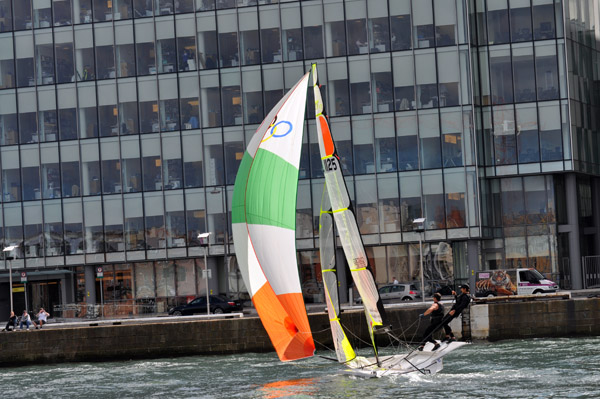
Action on the Liffey. Photo: Harry Hermon
Big Breeze Brings Big Results in Weymouth
Peter O'Leary and newly adopted German crew Frithjof Kleen were winners in the single Star keelboat race today but only after an international jury granted redress to the Cork helmsman who crossed the line second at the Skandia Sail for Gold regatta in Weymouth this afternoon. A second win for Ireland was secured in the big breeze by Annalise Murphy in the Laser Radial class who also scored second in this morning's race, rounding off a successful day for the 11 strong Irish crew off the Portland Bill. Below is a podcast update from Team Manager James O'Callaghan as the crews came off the water this evening.
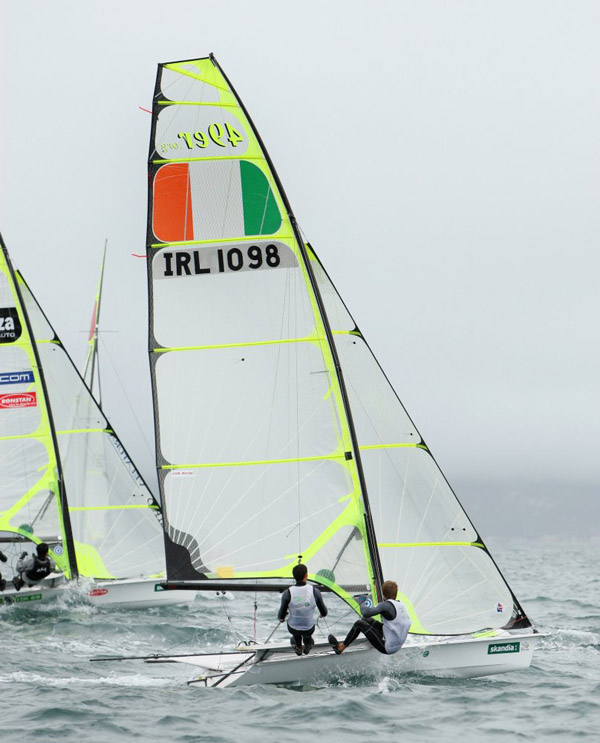
(Above) Ed Butler and Ben Lynch (IRL) in action in the 49er class on day 2 of the Skandia Sail for Gold Regatta and (below) Saskia Tidey in the Laser Radial . Photo OnEdition

Seven crews line up for Delta Lloyd
Seven Irish crews are on the entry list for the Delta Lloyd regatta starting on May 26, with representatives in six Olympic classes. Sisters Annalise and Claudine Murphy will compete in the Laser Radial class, with Ross Hamilton in the Finn the only other single-hander on the list.
Thomas Chaix and Barry McCartin continue their nascent 470 campaign, and Ireland is represented twice in the 49er class, with Ryan Seaton and Matt McGovern facing a better-trained Ger Owens & Ross Killian wo emerge from several weeks' training in Palma for this event (see yesterday's podcast for more).
However, the eye-catching pairing is Peter O'Leary and David Burrows, who finally join forces for a Star regatta. Burrows steps in to replace Ballyholme sailor Stephen Milne to face a small but competitive Star fleet ahead of the European Championships in early June.




























